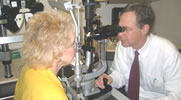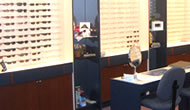|
Cataract Surgery
 Your eye has a clear lens through which light passes, allowing you to see. When the lens loses its transparency, the cloudy tissue that develops is known as a cataract. Your eye has a clear lens through which light passes, allowing you to see. When the lens loses its transparency, the cloudy tissue that develops is known as a cataract.
Cataracts cause progressive, painless loss of vision. The lens clouds naturally as we age, so people over the age of 65 usually see a gradual reduction of vision. No one is exactly sure what causes cataracts. In younger people they can result from an injury, certain medications, or illnesses such as diabetes. Prolonged exposure to ultraviolet light may also play a role in the formation of cataracts. Studies have also shown that people who smoke cigarettes have a higher risk of developing cataracts than non-smokers.
Although cataracts usually develop without apparent pain, some indications that a cataract may be forming are:
- Blurred or hazy vision
- Double vision
- Poor vision in bright light
- Seeing halos around lights
- Yellowish tinged vision
- Night vision difficulty
If visual impairment interferes with your ability to read, work, or do the things you enjoy then you will want to consider cataract surgery. Surgery is the only proven means of effectively treating cataracts. Cataract surgery is a relatively painless and is one of the most frequently performed procedures. It has a very high success rate and more than 90 percent of cataract surgery patients regain useful vision.
Contact us for more information on Cataracts
^top
Laser Cataract Surgery
 Going beyond traditional cataract surgery methods, Excel Eye Care & Surgery Center is proud to offer the latest, most innovative eye surgery technique - laser cataract surgery. Going beyond traditional cataract surgery methods, Excel Eye Care & Surgery Center is proud to offer the latest, most innovative eye surgery technique - laser cataract surgery.
Utilizing bladeless laser technology, this type of cataract surgery provides a custom-tailored solution for effective cataract removal.
This advanced laser technology provides our patients with the safest, most gentle cataract surgery method available today. A laser cataract surgery accomplishes many of the manual surgical steps such as primary and secondary incisions; capsulorhexis; lens fragmentation and astigmatism correction. The near perfect circular incision helps with better lens positioning.
Laser cataract surgery allows your cataract surgeon to use a computer-controlled laser to remove your cataracts to exact specifications for a truly customized procedure.
Our unique LenSx® Laser utilizes integrated optical coherence tomography (OCT) and related software to capture and analyze precise, high-resolution images of your eyes, providing your surgeon with accurate, real-time visuals throughout the laser cataract surgery procedure.
Simply by having your cataract removed and an implant (IOL) placed your vision will improve. Most patients that require glasses after cataract surgery for their driving or distance vision have treatable astigmatism. Astigmatism is caused by an irregular curvature of the cornea or lens. The shape is more like a football than a basketball. If left untreated, it affects your vision at all ranges and hampers the ability to see fine details. Full time use of glasses will be necessary to achieve clear vision. Near, distance and intermediate vision is distorted because light rays are not focused on a single spot on the retina.
Dr. Haberman is using Femtosecond laser technology during cataract surgery to treat astigmatism. By using the laser's computer guided imaging, Dr. Haberman can safely reduce a patient's corneal astigmatism. With exacting precision the laser creates small incisions to smooth out the shape of the cornea. For patients that have large amounts of astigmatism or are not candidates for laser, Dr. Haberman also recommends Toric IOL's to correct astigmatism. These lenses are used in place of a standard IOL. In some cases, both advances can be used.
View Video
Contact us for more information on Laser Cataract Surgery
^top
Glaucoma Treatment
 Glaucoma is the leading cause of blindness and visual impairment in the United States. A simple, painless eye exam can detect the disease. With early detection and treatment, glaucoma can usually be controlled and blindness prevented. Glaucoma is the leading cause of blindness and visual impairment in the United States. A simple, painless eye exam can detect the disease. With early detection and treatment, glaucoma can usually be controlled and blindness prevented.
Glaucoma can affect anyone from newborn infants to the elderly. It has been estimated that up to 3 million Americans have glaucoma. At least half of those people do not know they have it because glaucoma usually has no symptoms. People who are at a greater risk for glaucoma usually have the following conditions:
- At least 45 years old without regular eye exams
- A family history of glaucoma
- Abnormally high eye pressure
- African descent
- Nearsightedness
- Diabetes
- Previous eye injury
- Regular, long-term use of cortisone/steroid products
To detect glaucoma, your physician will test your visual acuity and visual field, dilate your pupils and test the pressure in your eye. Regular and complete eye exams help to monitor the changes in your eyesight and to determine whether you may develop glaucoma. Treatment to control glaucoma include medications in the form of either eyedrops or pills, laser surgery and conventional surgery.
Contact us for more information on Glaucoma
^top
General Eye Care
 Children should have their first eye exam at about age two, although it’s never to early to test a child’s vision and eye health. Comprehensive eye exams are essential in the diagnosis and treatment of vision problems, injury and disease. Early detection allows for treatment to begin before the child experiences difficulty in school due to poor vision, or before any permanent damage has been done to the eye(s). Exams test visual acuity, eye tracking, and focusing skills, and detect problems such as near- and far-sightedness, amblyopia, crossed eyes, dyslexia, and color blindness. Children should have their first eye exam at about age two, although it’s never to early to test a child’s vision and eye health. Comprehensive eye exams are essential in the diagnosis and treatment of vision problems, injury and disease. Early detection allows for treatment to begin before the child experiences difficulty in school due to poor vision, or before any permanent damage has been done to the eye(s). Exams test visual acuity, eye tracking, and focusing skills, and detect problems such as near- and far-sightedness, amblyopia, crossed eyes, dyslexia, and color blindness.
Contact us for more information on General Eye Care
Optical Services
 Glasses and contact lenses correct refractive errors such as nearsightedness, farsightedness and astigmatism. Prescriptions are measured for each eye so patients can enjoy optimal vision clarity, usually 20/20. Eyewear may be used for certain activities, such as reading for hyperopic patients and driving or watching television for myopic patients, or may be worn at all times. Glasses and contact lenses correct refractive errors such as nearsightedness, farsightedness and astigmatism. Prescriptions are measured for each eye so patients can enjoy optimal vision clarity, usually 20/20. Eyewear may be used for certain activities, such as reading for hyperopic patients and driving or watching television for myopic patients, or may be worn at all times.
Contact us for more information on Optical Services
^top
|

